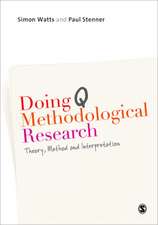Essential First Steps to Data Analysis: Scenario-Based Examples Using SPSS
Autor Carol S. Parkeen Limba Engleză Paperback – 4 feb 2013
Preț: 474.15 lei
Nou
Puncte Express: 711
Preț estimativ în valută:
90.73€ • 95.05$ • 75.19£
90.73€ • 95.05$ • 75.19£
Carte tipărită la comandă
Livrare economică 08-22 aprilie
Preluare comenzi: 021 569.72.76
Specificații
ISBN-13: 9781412997515
ISBN-10: 1412997518
Pagini: 288
Dimensiuni: 187 x 232 x 19 mm
Greutate: 0.41 kg
Ediția:1
Editura: SAGE Publications
Colecția Sage Publications, Inc
Locul publicării:Thousand Oaks, United States
ISBN-10: 1412997518
Pagini: 288
Dimensiuni: 187 x 232 x 19 mm
Greutate: 0.41 kg
Ediția:1
Editura: SAGE Publications
Colecția Sage Publications, Inc
Locul publicării:Thousand Oaks, United States
Recenzii
Having different research studies presented rather than using the same context throughout the text helps keep the material more interesting for the reader, as well as helping students generalize their learning across different research contexts.
The ‘real world’ scenarios captivate the reader but also provide pertinent context to see just how it relates to the content area at hand in each module.
The strength of the text is in how the author identifies the goals of the analysis under discussion and then steps the reader through the tasks necessary to realize those goals.
There are not many texts on data preparation in the field, so I believe this text would provide a unique contribution. …I agree wholeheartedly with the preface, that the other guides are simple “how-to” books that do not effectively connect students with real examples that can serve as a guideline in their own analysis experiences.
A key strength of this text is that it focuses on the practical aspects of MANAGING research data rather than statistical programming or statistical analysis.
I like that the book is written with cases/stories—I think that especially for counseling/psych students, these stories are going to help them contextualize the ideas more so than they would without these stories. I also like that the book give the students example write-ups. I think that is a priceless addition to any textbook about conducting statistical tests.
The ‘real world’ scenarios captivate the reader but also provide pertinent context to see just how it relates to the content area at hand in each module.
The strength of the text is in how the author identifies the goals of the analysis under discussion and then steps the reader through the tasks necessary to realize those goals.
There are not many texts on data preparation in the field, so I believe this text would provide a unique contribution. …I agree wholeheartedly with the preface, that the other guides are simple “how-to” books that do not effectively connect students with real examples that can serve as a guideline in their own analysis experiences.
A key strength of this text is that it focuses on the practical aspects of MANAGING research data rather than statistical programming or statistical analysis.
I like that the book is written with cases/stories—I think that especially for counseling/psych students, these stories are going to help them contextualize the ideas more so than they would without these stories. I also like that the book give the students example write-ups. I think that is a priceless addition to any textbook about conducting statistical tests.
Cuprins
Section 1. The Sample
Module 1. Checking the Representativeness of a Sample
Module 2. Splitting a File, Selecting Cases, Creating Standardized Values and Ranks
Section 2. Nature and Distribution of Variables
Module 3. Recoding, Counting, and Computing Variables
Module 4. Determining the Scale of a Variable
Module 5. Identifying and Addressing Outliers
Section 3. Model Assumptions
Module 6. Evaluating Model Assumptions for Testing Mean Differences
Module 7. Evaluating Model Assumptions for Multiple Regression Analysis
Section 4. Missing Data
Module 8. Determining the Quantity and Nature of Missing Data
Module 9. Quantifying Missing Data and Diagnosing its Patterns
Section 5. Working with Multiple Data Files
Module 10. Merging Files
Module 11. Aggregating Data and Restructuring Files
Module 12. Identifying a Cohort of Students
Module 1. Checking the Representativeness of a Sample
Module 2. Splitting a File, Selecting Cases, Creating Standardized Values and Ranks
Section 2. Nature and Distribution of Variables
Module 3. Recoding, Counting, and Computing Variables
Module 4. Determining the Scale of a Variable
Module 5. Identifying and Addressing Outliers
Section 3. Model Assumptions
Module 6. Evaluating Model Assumptions for Testing Mean Differences
Module 7. Evaluating Model Assumptions for Multiple Regression Analysis
Section 4. Missing Data
Module 8. Determining the Quantity and Nature of Missing Data
Module 9. Quantifying Missing Data and Diagnosing its Patterns
Section 5. Working with Multiple Data Files
Module 10. Merging Files
Module 11. Aggregating Data and Restructuring Files
Module 12. Identifying a Cohort of Students
Notă biografică
Descriere
Provides instruction and guidance on preparing quantitative data sets prior to answering a study's research questions




